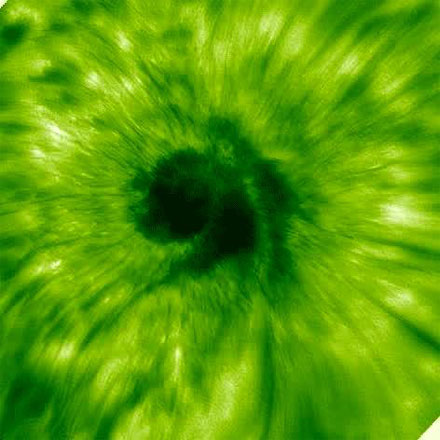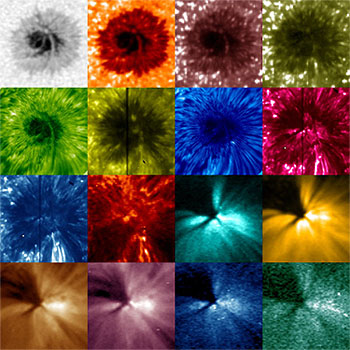The ability to track a particular kind of solar wave as it sweeps upward from the sun's surface through the sun's atmosphere is widening astrophysics’ understanding of how solar material travels throughout the sun.
Though scientists have long suspected that the waves they spot in the sun's photosphere are linked to those seen in the sun's chromosphere, novel imaging tools have now enabled scientists to actually watch the wave travel up through the various layers into the sun's atmosphere.

Scientists analyzed sunspot images from a trio of observatories —
including the Big Bear Solar Observatory, which captured this footage —
to make the first-ever observations of a solar wave traveling up into
the sun's atmosphere from a sunspot. Courtesy of BBSO/Zhao et al.
By applying a time-distance helioseismic analysis over a suite of multi-wavelength observations above a sunspot, scientists at NASA's Goddard Space Flight Center and Stanford University have demonstrated that helioseismic p-mode waves were able to channel up from the sun's photosphere through the chromosphere and transition region into the corona.
The scientists’ numerical simulation of the traveling of waves from a subphotospheric source qualitatively resembled the observed properties of the waves and offered an interpretation of the shapes of the wavefronts above the photosphere.
The study used data captured by NASA's Solar Dynamics Observatory (SDO), NASA's Interface Region Imaging Spectrograph, and the Big Bear Solar Observatory. Together, these observatories watch the sun in 16 wavelengths of light that show the sun's surface and lower atmosphere. SDO alone captures 11 of these wavelengths.

Scientists used data from NASA's Solar Dynamics Observatory, NASA's
Interface Region Imaging Spectrograph and the Big Bear Solar Observatory
to track a solar wave as it channeled upward from the sun's surface
into the atmosphere. Courtesy of Zhao et al/NASA/SDO/IRIS/BBSO.
"SDO takes images of the sun in many different wavelengths at a high time resolution," said Dean Pesnell, SDO project scientist at Goddard. "That lets you see the frequencies of these waves. If you didn't have such rapid-fire images, you'd lose track of the waves from one image to the next."
In addition to providing scientists with a novel tool for studying the sun’s atmosphere, the ability to track the progress of solar waves is helping scientists pinpoint the mechanism that moves energy into the sun's corona.
"We see certain kinds of solar seismic waves channeling upwards into the lower atmosphere, called the chromosphere, and from there, into the corona," said Junwei Zhao, a solar scientist at Stanford University. "This research gives us a new viewpoint to look at waves that can contribute to the energy of the atmosphere."
The research was published in The Astrophysical Journal Letters (doi: 10.3847/2041-8205/830/1/L17).